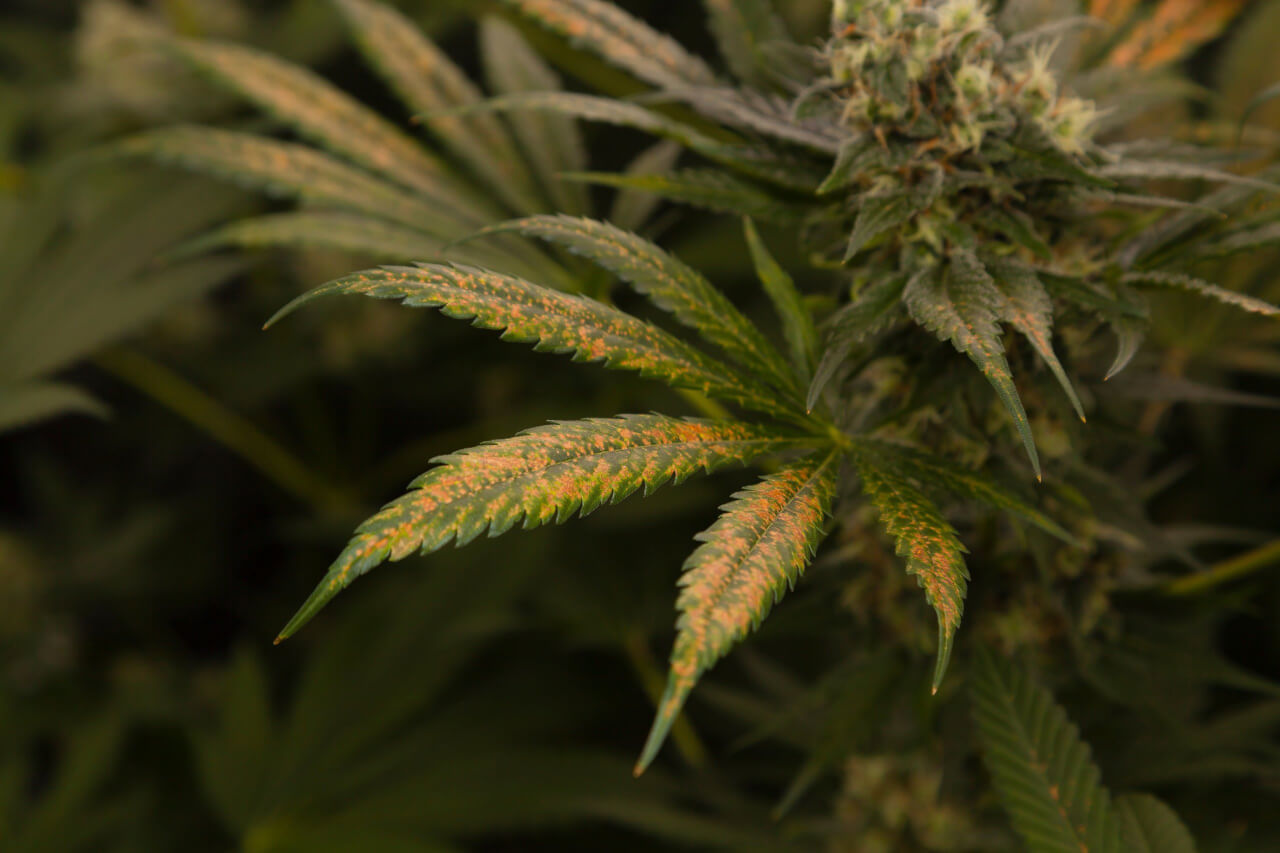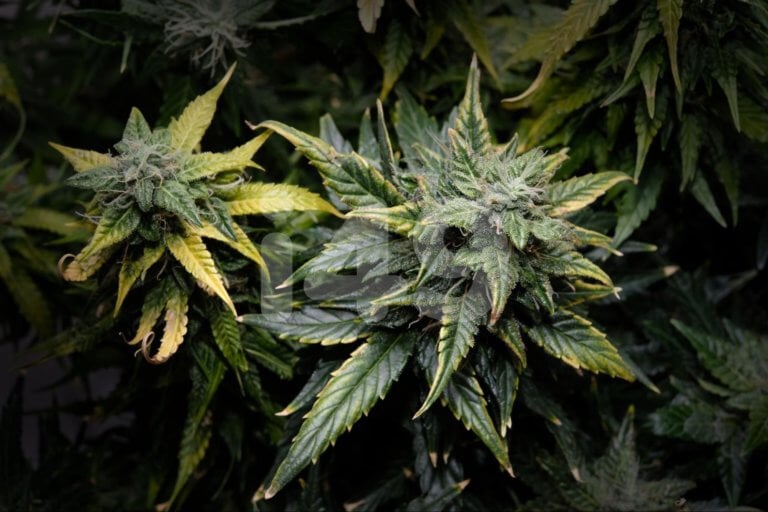
Manganese Deficiency in Cannabis: How to Fix It
Apr 6, 2020
Nutrient Problems
Content
- What does manganese (Mn) do for a cannabis plant?
- What causes a weed manganese deficiency
- Symptoms of a manganese deficiency in weed plants
- How to fix a manganese deficiency in cannabis
- How to distinguish manganese deficiency from other cannabis deficiencies
- Preventing a manganese deficiency
- Manganese deficiency: Preventable and treatable
A manganese deficiency in cannabis is guaranteed to alarm a grower seeing it for the first time. Previously healthy leaves turn brown, dead patches spread, and the foliage starts to shed.
What is manganese, and why does a lack of it cause crop decline?
This mineral is only present in trace amounts in marijuana. Nevertheless, it plays vital roles in maintaining plant health, and cultivators can’t have a prosperous garden without it.
Luckily, troubleshooting is straightforward once you know what you’re seeing. Keep reading to learn about this crop issue. We discuss signs, causes, solutions, and ways to prevent shortages in future grow-ops.
Let’s jump into it.

What does manganese (Mn) do for a cannabis plant?
Manganese (Mn) is a gray metal often found in combination with iron. It’s an essential micronutrient for human bodies, feeding our connective tissues and supporting our metabolic processes. The mineral’s role in cannabis is just as important.
Manganese supports growth and photosynthesis in plants. It assists with chlorophyll production, giving the foliage its healthy green color.
The nutrient also helps crops turn water and oxygen into sugars for energy and indirectly helps marijuana maintain its structural integrity.
When there’s a manganese deficiency in cannabis, the plant loses its greenery and may cease growing. Even the bushiest specimen raised from hybrid weed seeds appears thin and lifeless due to the mineral’s absence.
Despite this fact, cultivators rarely supplement manganese. Most natural soils and potting mixes contain more than enough to sustain growth. What’s to blame, then?
An Mn deficiency follows adverse chemical reactions between the substrate and the roots.
What causes a weed manganese deficiency
Marijuana uses tiny amounts of manganese to function. As most soils contain this mineral, outdoor conditions might compromise its availability. A manganese deficiency in weed occurs because of pH imbalances and excessive iron in the substrate.
Because it affects nutrient availability, pH is a frequent cause of deficiencies. Some elements get locked out when the environment is too acidic or alkaline. The grower provides plenty of food, but the soil chemistry prevents the roots from absorbing it, and crops remain hungry.
Cannabis thrives in a pH of 5.5–6.2, tolerating anything in the 5.0–7.0 range. However, manganese becomes unavailable to the roots when the soil pH rises over 6.5. The same conditions result in an iron deficiency.
Another cause of Mn shortage might be too much iron. These two minerals compete for absorption, and an extreme amount of one blocks the other. Cultivators may trigger the interaction by using iron chelates, manure, or blood meal as fertilizers.
Once either of these conditions takes effect, the plant uses up any stored manganese and then displays deficiency symptoms. Let’s see how it might exhibit this deficit.
Symptoms of a manganese deficiency in weed plants
Manganese is essential for photosynthesis and growth, and its scarcity shows. The symptoms mostly appear on the leaf blades, which lose color and vitality.

Cannabis manganese deficiency indications include:
- Browning leaves with green veins

- New growth quickly turning yellow

- Spots or markings across the foliage

- Slowed and stunted leaf development
This problem occurs in stages, with the discoloration and the spotting worsening over time.

Shortages primarily affect the foliage but can spread to the buds and branches when left untreated. Colas might die off, and even phenotypes from mold-resistant seeds become vulnerable to damage and disease.
What’s more, this deficiency affects old and new growth alike. Blades go yellow between leaf veins in a patchy pattern.
How to fix a manganese deficiency in cannabis
Don’t rush to acquire a manganese supplement for plants as soon as you suspect this shortage. Since it results from a chemical imbalance, adding more crop food does nothing but waste money and increase substrate toxicity.
The first step is to test your soil pH and check whether alkalinity is behind the symptoms. As a rule, here are the readings that correspond to optimal manganese intake:
- 6.0–6.5 in soil
- 5.5–6.0 in hydro
Broader ranges are generally acceptable, but going higher might lock out the mineral. Excess iron might be an issue in treated and sandy substrates, so consider this scenario if the pH is in order.
In either case, flushing is the best response to a manganese deficiency. This process restores pH balance and cleanses iron buildup from the substrate. Doing so prepares the soil for a fresh dose of beneficial plant food.
Here’s how to flush:
- Get four times the pot capacity of pH-neutral water. So, 16 gallons for a 4-gallon container.
- Shower the soil with this liquid, pouring slowly and allowing it to drain from the bottom of the container.
- Leave the pot in a breezy spot to dry before supplementing moisture and nutrients.
Tip: If you suspect your substrate or water is causing an imbalance, treat them with a pH-Up or pH-Down solution.
Once you flush the soil, it’s at an optimal range for nutrient absorption and growth. Then it’s time to add a new source of balanced minerals.
Here’s how to add manganese to soil:
- Dissolve the appropriate dose of broad-spectrum fertilizer in H20 and generously shower your plants.
- Use an Mn-specific nutrient booster with the following two waterings to facilitate recovery.
Follow the manufacturer’s instructions on the feeding dose for both solutions. The extra manganese clears any lingering symptoms, while the regular fertilizer nourishes the crop back to health.
This long-term solution pairs best with cannabis foliar feeding to provide short-term relief. The method involves spraying the foliage with a blend of nutrients and water. The blades take up the food and replenish their manganese stocks faster.

Once you’ve addressed the root cause of this deficiency, the symptoms should stop spreading within a week. However, the damaged leaves won’t turn green again. It’s best to prune cannabis plants of this dead weight and use new growth to gauge recovery.
What if the crop is late into flowering? It won’t sprout new blades, but removing the dead ones helps. Otherwise, this ill growth can become a breeding ground for pathogens.
How to distinguish manganese deficiency from other cannabis deficiencies
Many weed nutrient deficiencies manifest similarly, and supplying more of the wrong mineral can exacerbate the issue. How do you ensure you’re having manganese troubles?
Although symptoms may be misleading, most scarcities have unique traits to help you tell them apart. At first glance, growers might mistake a manganese shortage for these three deficiencies:
- Nitrogen deficits lead to leaf yellowing, withering, and eventual death. Unlike a lack of manganese, this shortage first induces trouble along the crop base. It’s predominantly the older growth that discolors.

- Calcium deficiency turns the leaves dark and sprinkles them with brown spots, which eventually become large dead patches. Like nitrogen, this issue begins in older growth and only affects new sprouts in later stages.

- A lack of copper can cause yellow leaves, but they mainly lose color along the edges and tips. The foliage becomes dark and shiny, displaying blue or purple undertones.

If you’re unsure of which shortage you’re dealing with, test your fertilizer and growing environment. The pH, water chemistry, and type of nutrients used can assist you in making an accurate diagnosis.
Preventing a manganese deficiency
You now know how to fix manganese deficiency in plants, but why let it happen in the first place? Good gardening practices can nip most nutrient problems in the bud. In this case, your focus areas are careful pH monitoring and well-balanced feeding.
Monitor pH regularly. Invest in a meter and perform a check during each feeding. Test your water, H2O-fertilizer blend, and runoff liquid. These steps gauge the acidity of the moisture source, nutrient solution, and substrate to catch any imbalances early.
Choose the best cannabis nutrients containing optimized doses of all elements. More isn’t always better, so strive for balance rather than impressive numbers. Avoid synthetic fertilizers to prevent salt buildup and future troubles.
Manganese deficiency: Preventable and treatable
A manganese deficiency in marijuana is concerning, and it might be fatal. However, if growers notice the shortage and respond proactively, crops return to tip-top shape in a few weeks.
Stay mindful of your substrate’s pH and iron levels to avoid scarcity of Mn altogether. If a mineral deficit does happen, cut your losses and remove the dead leaves. Cannabis is sturdy and recovers with surprising speed when well-fed, so don’t lose hope of bountiful harvests.
Our guides equip you to combat cultivation pitfalls and produce quality weed at home. Head to our shop to buy seeds and start your growing operation today.











